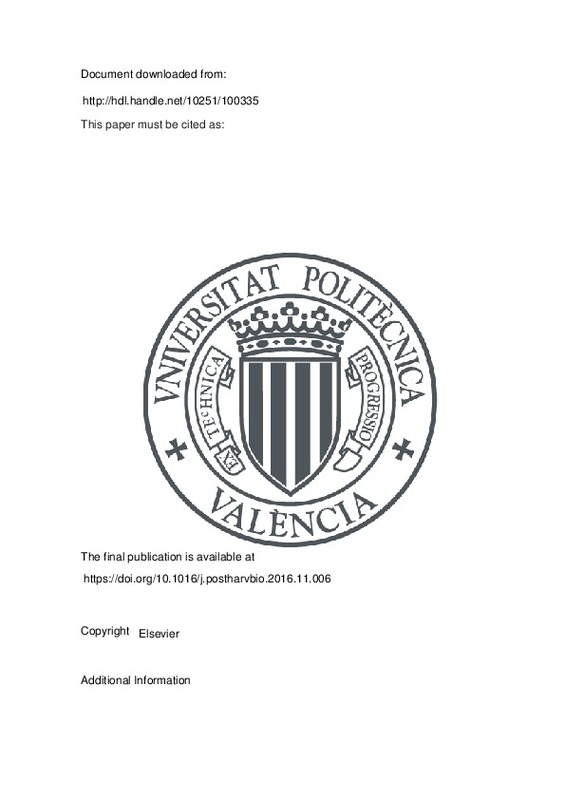JavaScript is disabled for your browser. Some features of this site may not work without it.
Buscar en RiuNet
Listar
Mi cuenta
Estadísticas
Ayuda RiuNet
Admin. UPV
Astringency assessment of persimmon by hyperspectral imaging
Mostrar el registro sencillo del ítem
Ficheros en el ítem
| dc.contributor.author | Munera Picazo, Sandra Maria
|
es_ES |
| dc.contributor.author | Besada Ferreiro, Cristina María
|
es_ES |
| dc.contributor.author | Blasco Ivars, José
|
es_ES |
| dc.contributor.author | Cubero-García, Sergio
|
es_ES |
| dc.contributor.author | Salvador, Alejandra
|
es_ES |
| dc.contributor.author | Talens Oliag, Pau
|
es_ES |
| dc.contributor.author | Aleixos Borrás, María Nuria
|
es_ES |
| dc.date.accessioned | 2018-04-13T04:15:51Z | |
| dc.date.available | 2018-04-13T04:15:51Z | |
| dc.date.issued | 2017 | es_ES |
| dc.identifier.issn | 0925-5214 | es_ES |
| dc.identifier.uri | http://hdl.handle.net/10251/100335 | |
| dc.description.abstract | [EN] One of the current challenges of persimmon postharvest research is the development of non-destructive methods that allow determination of the internal properties of the fruit, such as maturity, flesh firmness and astringency. This study evaluates the usefulness of hyperspectral imaging in the 460 1020 nm range as a non-destructive tool to achieve these aims in Persimmon cv. Rojo Brillante which is an astringent cultivar. Fruit were harvested at three different stages of commercial maturity and exposed to different treatments of CO2 (95% CO2 20 ºC from 0 to 24 h) in order to obtain fruit with different levels of astringency. Partial Least Square (PLS) based methods were used to classify persimmon fruits by maturity and to predict flesh firmness from the average spectrum of each fruit. The results showed a 97.9% rate of correct maturity classification and an R2P of 0.80 for firmness prediction with only five selected wavelengths. For astringency assessment, as our results showed that the soluble tannins that remain after CO2 treatments are distributed irregularly inside the flesh, a model based on PLS was built using the spectrum of every pixel in the fruit. The model obtained an R2P of 0.91 which allowed the creation of the predicted distribution maps of the tannins in the flesh of the fruit, thereby pointing to hyperspectral systems as a promising technology to assess the effectiveness of the deastringency treatments that are usually applied before commercialising persimmons from astringent cultivars. | es_ES |
| dc.description.sponsorship | This work has been partially funded by the Instituto Nacional de Investigacion y Tecnologia Agraria y Alimentaria de Espana (INIA) through projects RTA2012-00062-C04-01, RTA2012-00062-C04-03 and RTA2013-00043-C02 with the support of FEDER funds and by the Conselleria d' Educacio, Investigacio, Cultura i Esport, Generalitat Valenciana, through the project AICO/2015/122. Sandra Munera thanks INIA for the grant FPI-INIA #43 (CPR2014-0082) partially supported by FSE funds. | en_EN |
| dc.language | Inglés | es_ES |
| dc.publisher | Elsevier | es_ES |
| dc.relation.ispartof | Postharvest Biology and Technology | es_ES |
| dc.rights | Reserva de todos los derechos | es_ES |
| dc.subject | Diospyros kaki | es_ES |
| dc.subject | Fruit internal quality | es_ES |
| dc.subject | Soluble tannins | es_ES |
| dc.subject | Distribution map | es_ES |
| dc.subject | Hyperspectral imaging | es_ES |
| dc.subject | Computer vision | es_ES |
| dc.subject.classification | EXPRESION GRAFICA EN LA INGENIERIA | es_ES |
| dc.subject.classification | TECNOLOGIA DE ALIMENTOS | es_ES |
| dc.title | Astringency assessment of persimmon by hyperspectral imaging | es_ES |
| dc.type | Artículo | es_ES |
| dc.identifier.doi | 10.1016/j.postharvbio.2016.11.006 | es_ES |
| dc.relation.projectID | info:eu-repo/grantAgreement/Generalitat Valenciana//AICO%2F2015%2F122/ES/INCORPORACION DE NUEVAS TECNOLOGIAS OPTICAS NO DESTRUCTIVAS PARA EVALUAR LA CALIDAD Y SEGURIDAD ALIMENTARIA DE FRUTAS/ | es_ES |
| dc.relation.projectID | info:eu-repo/grantAgreement/MINECO//RTA2012-00062-C04-03/ES/Nuevas técnicas de inspección basadas en visión por computador multiespectral para la estimación de propiedades y determinación automática de la calidad y sanidad de la producción agroalimentaria en líneas de inspección y manipulación (VIS-DACSA)/ | es_ES |
| dc.rights.accessRights | Abierto | es_ES |
| dc.date.embargoEndDate | 2019-03-01 | es_ES |
| dc.contributor.affiliation | Universitat Politècnica de València. Departamento de Mecanización y Tecnología Agraria - Departament de Mecanització i Tecnologia Agrària | es_ES |
| dc.contributor.affiliation | Universitat Politècnica de València. Departamento de Tecnología de Alimentos - Departament de Tecnologia d'Aliments | es_ES |
| dc.contributor.affiliation | Universitat Politècnica de València. Departamento de Ingeniería Gráfica - Departament d'Enginyeria Gràfica | es_ES |
| dc.description.accrualMethod | S | es_ES |
| dc.relation.publisherversion | https://doi.org/10.1016/j.postharvbio.2016.11.006 | es_ES |
| dc.description.upvformatpinicio | 35 | es_ES |
| dc.description.upvformatpfin | 41 | es_ES |
| dc.type.version | info:eu-repo/semantics/publishedVersion | es_ES |
| dc.description.volume | 125 | es_ES |
| dc.relation.pasarela | S\320366 | es_ES |
| dc.contributor.funder | Generalitat Valenciana | es_ES |
| dc.contributor.funder | Ministerio de Economía y Competitividad | es_ES |







![[Cerrado]](/themes/UPV/images/candado.png)

